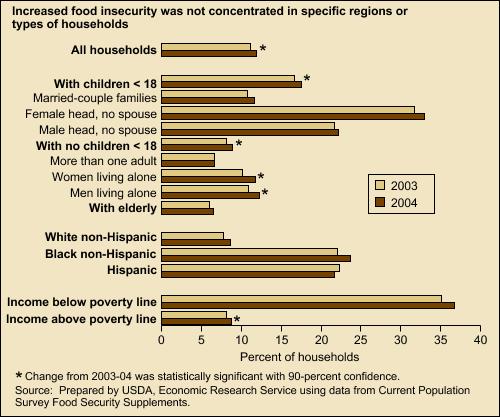More Households Had Difficulty Meeting Their Food Needs
- by Mark Nord
- 2/1/2014
The food security of the Nation’s households—their consistent access to enough food for active, healthy living—declined from 2003 to 2004. Although 88 percent of U.S. households were food secure throughout the year in 2004, the percentage of households that were food insecure at least some time during the year rose from 11.2 percent in 2003 to 11.9 percent in 2004. Over the same period, the percentage that were food insecure with hunger also increased, from 3.5 to 3.9 percent. The condition “food insecure with hunger” means that, at times during the year, one or more household members were hungry because of insufficient money and other resources for food.
The increase in the prevalence of food insecurity from 2003 to 2004 appears to have occurred in most regions and most types of households. The prevalence of food insecurity increased for households with children, households without children, women living alone, men living alone, households with incomes above the Federal poverty line ($19,157 for a family of four in 2004), and households in the Midwest and South. All other categories and regions also showed increases, except for Hispanic-headed households, but were within ranges that could have resulted from sampling variation.
In both 2003 and 2004, the prevalence of food insecurity was about twice as high for households with children as for households without children. Single women with children were particularly likely to have difficulty putting enough food on the table—about one in three were food insecure in each year. Single men with children were also more likely than the average U.S. household to be food insecure, although not as likely as single women with children. Households consisting of two or more adults with no children present and households with elderly members were less likely than the average U.S. household to have reported difficulties meeting their food needs. Black and Hispanic households had rates of food insecurity more than twice those of White non-Hispanic households.
Food insecurity is strongly linked to income. Households with incomes below the Federal poverty line were about four times as likely to be food insecure as households with incomes above that level. Food insecurity was somewhat more prevalent in the South and West than in the Northeast and Midwest.
This article is drawn from:
- Food Security in the U.S.. (n.d.). U.S. Department of Agriculture, Economic Research Service.



